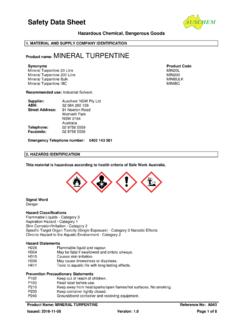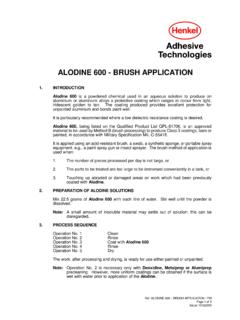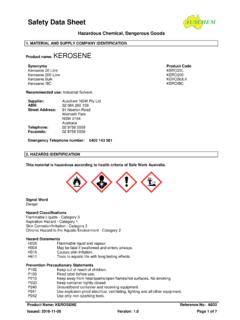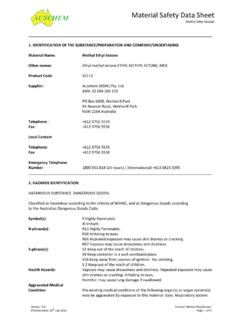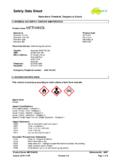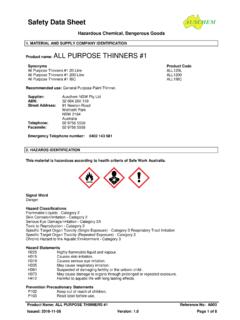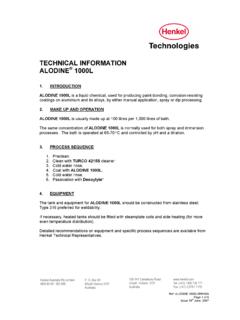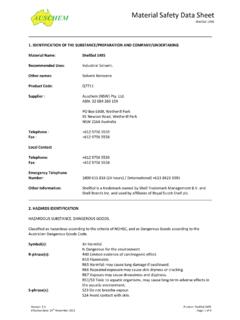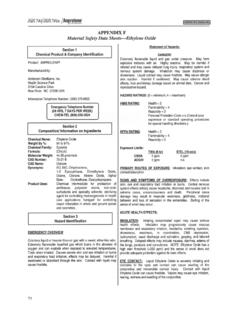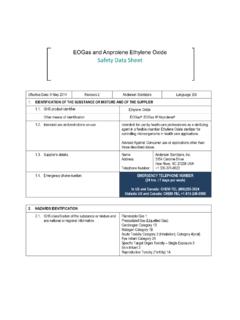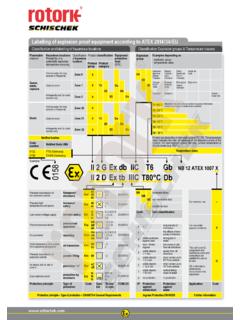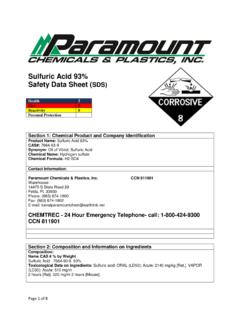Transcription of Methylene Chloride - UG - Solvents
1 Product Name: Methylene Chloride - UG MATERIAL SAFETY DATA SHEET Page: 1 of 6 This revision issued: July, 2010 Issued by: Solvents Australia Pty Ltd Phone: 02 9979 6866 Poisons Information Centre: 13 1126 from anywhere in Australia, (0800 764 766 in New Zealand) Section 1 - Identification of The Material and Supplier Chemical nature: Chlorinated hydrocarbon; stabiliser is added. Trade Name: Methylene Chloride - UG Product Use: Solvent. Creation Date: August, 2007 This version issued: July, 2010 and is valid for 5 years from this date. SECTION 2 - HAZARDS IDENTIFICATION Statement of Hazardous Nature This product is classified as: Xn, Harmful. Xi, Irritating. Hazardous according to the criteria of SWA. Dangerous according to the Australian Dangerous Goods (ADG) Code. Risk Phrases: R20, R40, R66, R36/38. Harmful by inhalation.
2 Limited evidence of a carcinogenic effect. Repeated exposure may cause skin dryness or cracking. Irritating to eyes and skin. Safety Phrases: S23, S24/25, S36/37. Do not breathe vapours. Avoid contact with skin and eyes. Wear suitable protective clothing and gloves. SUSDP Classification: S5 ADG Classification: Class : Toxic substances. UN Number: 1593, DICHLOROMETHANE Emergency Overview Physical Description & colour: Clear, colourless liquid. Odour: Sharp, penetrating odour. Major Health Hazards: limited evidence of a carcinogenic effect, irritating to eyes and skin, harmful if inhaled, repeated exposure may cause skin dryness or cracking. Potential Health Effects Repeated exposure to high concentrations may produce adverse effects on the liver and kidney. Studies in some animals have shown Methylene Chloride to be carcinogenic.
3 These effects are species specific and are of no relevance to human health. For human carcinogenicity studies, IARC states For no type of cancer was there a sufficiently consistent elevation of risk across studies to make a causal interpretation credible. Inhalation: Short term exposure: Harmful by inhalation. Continued or high exposures by inhalation will cause anaesthetic effects. This may result in a loss of consciousness and could prove fatal. Methylene Chloride is converted to carbon monoxide in the body, which reduces the oxygen carrying capacity of the blood. Skin Contact: Short term exposure: Available data indicates that this product is not harmful. It should present no hazards in normal use. However product is a skin irritant. Symptoms may include itchiness and reddening of contacted skin. Other symptoms may also become evident, but all should disappear once exposure has ceased.
4 Long Term exposure: No data for health effects associated with long term skin exposure. Eye Contact: Short term exposure: This product is an eye irritant. Symptoms may include stinging and reddening of eyes and watering which may become copious. Other symptoms may also become evident. If exposure is brief, symptoms Product Name: Methylene Chloride - UG MATERIAL SAFETY DATA SHEET Page: 2 of 6 This revision issued: July, 2010 Issued by: Solvents Australia Pty Ltd Phone: 02 9979 6866 Poisons Information Centre: 13 1126 from anywhere in Australia, (0800 764 766 in New Zealand) should disappear once exposure has ceased. However, lengthy exposure or delayed treatment may cause permanent damage. Long Term exposure: No data for health effects associated with long term eye exposure. Ingestion: Short term exposure: Significant oral exposure is considered to be unlikely.
5 This product, while believed to be not harmful, is likely to cause headache and gastric disturbance such as nausea and vomiting if ingested in significant quantities. However, this product may be irritating to mucous membranes but is unlikely to cause anything more than transient discomfort. Long Term exposure: No data for health effects associated with long term ingestion. Carcinogen Status: SWA: Dichloromethane is classified by SWA as a Class 3 Carcinogen, possibly carcinogenic to humans. 1,2-butylene Oxide is classified by SWA as a Class 3 Carcinogen, possibly carcinogenic to humans. See the SWA website for further details. A web address has not been provided as addresses frequently change. NTP: Dichloromethane is classified by NTP as reasonably anticipated to be carcinogenic to humans. See the NTP website for further details.
6 A web address has not been provided as addresses frequently change. IARC: Dichloromethane is classed 2b IARC - possibly carcinogenic to humans. 1,2-butylene Oxide is classed 2b IARC - possibly carcinogenic to humans. See the IARC website for further details. A web address has not been provided as addresses frequently change. SECTION 3 - COMPOSITION/INFORMATION ON INGREDIENTS Ingredients CAS No Conc,% TWA (mg/m3) STEL (mg/m3) Dichloromethane 75-09-2 >99 174 not set 1,2-butylene oxide 106-88-7 <1 not set not set This is a commercial product whose exact ratio of components may vary slightly.
7 Minor quantities of other non hazardous ingredients are also possible. The SWA TWA exposure value is the average airborne concentration of a particular substance when calculated over a normal 8 hour working day for a 5 day working week. The STEL (Short Term Exposure Limit) is an exposure value that may be equalled (but should not be exceeded) for no longer than 15 minutes and should not be repeated more than 4 times per day. There should be at least 60 minutes between successive exposures at the STEL. The term "peak "is used when the TWA limit, because of the rapid action of the substance, should never be exceeded, even briefly. SECTION 4 - FIRST AID MEASURES General Information: You should call The Poisons Information Centre if you feel that you may have been poisoned, burned or irritated by this product. The number is 13 1126 from anywhere in Australia (0800 764 766 in New Zealand) and is available at all times.
8 Have this MSDS with you when you call. Inhalation: If symptoms of poisoning become evident, contact a Poisons Information Centre, or call a doctor at once. Remove source of contamination or move victim to fresh air. If breathing is difficult, oxygen may be beneficial if administered by trained personnel, preferably on a doctor's advice. DO NOT allow victim to move about unnecessarily. Symptoms of pulmonary oedema can be delayed up to 48 hours after exposure. Skin Contact: Wash gently and thoroughly with warm water (use non-abrasive soap if necessary) for 10-20 minutes or until product is removed. Under running water, remove contaminated clothing, shoes and leather goods ( watchbands and belts) and completely decontaminate them before reuse or discard. If irritation persists, repeat flushing and seek medical attention.
9 Eye Contact: Immediately flush the contaminated eye(s) with lukewarm, gently flowing water for 20 minutes or until the product is removed, while holding the eyelid(s) open. Take care not to rinse contaminated water into the unaffected eye or onto the face. Obtain medical attention immediately. Take special care if exposed person is wearing contact lenses. Ingestion: If product is swallowed or gets in mouth, do NOT induce vomiting; wash mouth with water and give some water to drink. If symptoms develop, or if in doubt contact a Poisons Information Centre or a doctor. SECTION 5 - FIRE FIGHTING MEASURES Fire and Explosion Hazards: Explosive mixtures of Methylene Chloride and air can be formed, but are difficult to ignite and require high intensity sources of heat, such as welding arcs, sparks and flames or high temperatures and pressures; addition of small amounts of flammable substances to Methylene Chloride (such as flammable liquids or gases) and / or an increase in the oxygen content of the local atmosphere, may strongly enhance these effects.
10 Welding or cutting should not be carried out on any vessel likely to contain solvent because of the risk of explosion. Thermal decomposition will evolve toxic and corrosive vapours of hydrogen Chloride and phosgene. Containers may burst if overheated due to thermal expansion of the contents. Product Name: Methylene Chloride - UG MATERIAL SAFETY DATA SHEET Page: 3 of 6 This revision issued: July, 2010 Issued by: Solvents Australia Pty Ltd Phone: 02 9979 6866 Poisons Information Centre: 13 1126 from anywhere in Australia, (0800 764 766 in New Zealand) Extinguishing Media: Water fog or fine spray is the preferred medium for large fires. Try to contain spills, minimise spillage entering drains or water courses. Fire Fighting: If a significant quantity of this product is involved in a fire, call the fire brigade. There is little danger of a violent reaction or explosion if significant quantities of this product are involved in a fire.
